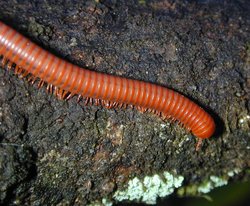Myriapoda
|
|
| Myriapoda | ||||||
|---|---|---|---|---|---|---|
 Rusty millipede (Trigoniulus corallinus) | ||||||
| Scientific classification | ||||||
| ||||||
| Classes | ||||||
|
Chilopoda - Centipedes |
Four groups of arthropods—the centipedes, millipedes, pauropods, and symphylans—share a number of common features such as a similar body plan consisting of a head followed by an elongate trunk with many legs. The four groups also exhibit marked differences.
Traditionally the myriapods have been considered close relatives of the insects and other Hexapoda, and united with them in the Subphylum Uniramia, among which the Myriapoda were treated as a class or superclass. Their status was questioned by some biologists (e.g. Barnes, 1968), and in particular it was considered likely that they were paraphyletic to the hexapods. However genetic studies support their monophyly, and suggest they may not be close relatives of the hexapods, instead belonging near the Chelicerata. This view is reflected by treating them as a separate subphylum within the Arthropoda.
Reference
- Barnes, R.D. 1968. Invertebrate Zoology. W.B. Saunders Co., Philadelphia. 743 p.
